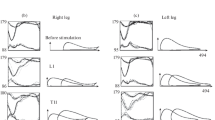Summary
This study examines the effect of removing input descending from the brain on the production of the distinctive leg motor patterns of walking and hatching by spinal circuitry of 0- to 3-day old posthatching chicks. Transection of the cervical spinal cord was performed and chicks were tested between 2 and 28 h after surgery. Walking with good weight support could be elicited from many spinal chicks when placed on a moving treadmill belt. In some cases, sensory stimulation resulting from tail and/or wing pinch was also used. Placing spinal chicks in the hatching position in glass eggs was sufficient to elicit hatching-like leg movements in some animals. Wing pinch was used to elicit more or longer episodes of leg movements. Quantitative analyses of EMG recordings from 6 leg muscles were used to evaluate the changes in motor patterns after cervical spinal transection. Most of the characteristic features of walking and hatching are maintained after descending input from the brain is eliminated. Each muscle is activated in the double or single bursting pattern typical of the normal behavior. Characteristic phase relationships are also preserved. In addition, burst duration versus cycle period relationships seen during the normal behaviors are maintained in the spinal animals. This shows that circuitry located in the spinal cord can produce these distinctive aspects of the hatching and walking motor patterns in the absence of brain input. While many features of walking and hatching patterns were maintained in spinal animals, some changes were noted. For example, although interlimb patterns of coordination are unchanged during spinal hatching and in many sequences of spinal walking, they do become more variable during some sequences of spinal walking. This suggests that descending input from the brain normally plays a role in stabilizing interlimb alternation during walking. An increase in cycle period is seen during walking in spinal chicks. In addition, the relative durations of hip and ankle flexor bursts (expressed as percent of cycle period) increase in both behaviors. Because these changes are also seen in chicks with lumbosacral deafferentations, they may represent the response of the pattern generating circuitry to any reduction in input. In some animals, cervical spinal transection was combined with lumbosacral deafferentation so that both brain input and sensory input from the legs were removed from the spinal cord. Results from these animals were similar to those from animals with deafferentation alone in that the walking and hatching patterns converged, but did not become identical (Bekoff et al. 1987). The remaining differences may be due to the use of some unique elements of pattern generating circuitry in each behavior, or to differences in the remaining input to the same pattern generating circuitry. A possible source for such differences in input is the undeafferented neck region.
Similar content being viewed by others
References
AVMA (American Veterinary Medical Association) (1978) Report of the AVMA panel on euthanasia. J Am Vet Med Assoc 173: 59–72
Barnes C, Schadt JC (1979) Release of function in the spinal cord. Prog Neurobiol 12: 1–13
Bekoff A (1976) Ontogeny of leg motor output in the chick embryo: a neural analysis. Brain Res 106: 271–291
Bekoff A (1984) Analysis of the role of descending input in the production of hatching and walking in chicks: spinal transection studies. Soc Neurosci Abstr 10: 755
Bekoff A, Kauer JA (1982) Neural control of hatching: role of neck position in turning on hatching leg movements in posthatching chicks. J Comp Physiol 145: 497–504
Bekoff A, Kauer JA (1984) Neural control of hatching: fate of the pattern generator for the leg movements of hatching in posthatching chicks. J Neurosci 4: 2659–2666
Bekoff A, Sabichi AL (1987) Sensory control of the initiation of hatching in chicks: effects of a local anesthetic injected into the neck. Dev Psychobiol 20: 489–495
Bekoff A, Nusbaum MP, Sabichi AL, Clifford M (1987) Neural control of limb coordination. I. Comparison of hatching and walking motor output patterns in normal and deafferented chicks. J Neurosci 7: 2320–2330
Bradley NS, Smith JL (1987) Neuromuscular patterns of Stereotypie hindlimb behaviors in the first two postnatal months. II. Stepping in spinal kittens. Dev Brain Res 38: 53–67
Bradley NS, Smith JL, Villabtanca JR (1983) Absence of hindlimb tactile placing in spinal cats and kittens. Exp Neurol 82: 73–88
Fayein NA, Viala D (1986) Development of locomotor activities in young chronic spinal rabbits. Neurosci Lett 3: 329–333
Forssberg H, Grillner S, Halbertsma J, Rossignol S (1980) The locomotion of the low spinal cat. II. Interlimb coordination. Acta Physiol Scand 108: 283–295
Grillner S (1981) Control of locomotion in bipeds, tetrapods and fish. In: Brooks VB (ed) The nervous system. American Physiological Society, Bethesda, Maryland (The handbook of physiology, sect. I, vol II, pt 2, pp 1179–1236)
Hamburger V, Oppenheim RW (1967) Prehatching motility and hatching behavior in the chick. J Exp Zool 166: 171–204
Jacobson R, Hollyday MA (1982a) A behavioral and electrophysiological study of walking in the chick. J Neurophysiol 48: 238–256
Jacobson R, Hollyday MA (1982b) Electrically evoked walking and fictive locomotion in the chick. J Neurophysiol 48: 257–270
Oppenheim RW (1975) The role of supraspinal input in embryonic motility: a reexamination in the chick. J Comp Neurol 160: 37–50
Oppenheim RW, Narayanan CH (1968) Experimental studies on hatching behavior in the chick. I. Thoracic spinal gaps. J Exp Zool 168: 387–394
Robinson GA, Goldberger ME (1985) Interfering with inhibition may improve motor function. Brain Res 346: 400–403
Robinson GA, Leonard CT, Goldberger ME (1982) Development of spinal locomotion in cats. Soc Neurosci Abstr 8: 969
Sholomenko GN, Steeves JD (1987) Effects of selective spinal cord lesions on hind limb locomotion in birds. Exp Neurol 95: 403–418
Zar JH (1985) Biostatistical analysis, 2nd edn. Prentice-Hall, Englewood Cliffs, New Jersey
Author information
Authors and Affiliations
Rights and permissions
About this article
Cite this article
Bekoff, A., Kauer, J.A., Fulstone, A. et al. Neural control of limb coordination. Exp Brain Res 74, 609–617 (1989). https://doi.org/10.1007/BF00247363
Received:
Accepted:
Issue Date:
DOI: https://doi.org/10.1007/BF00247363



